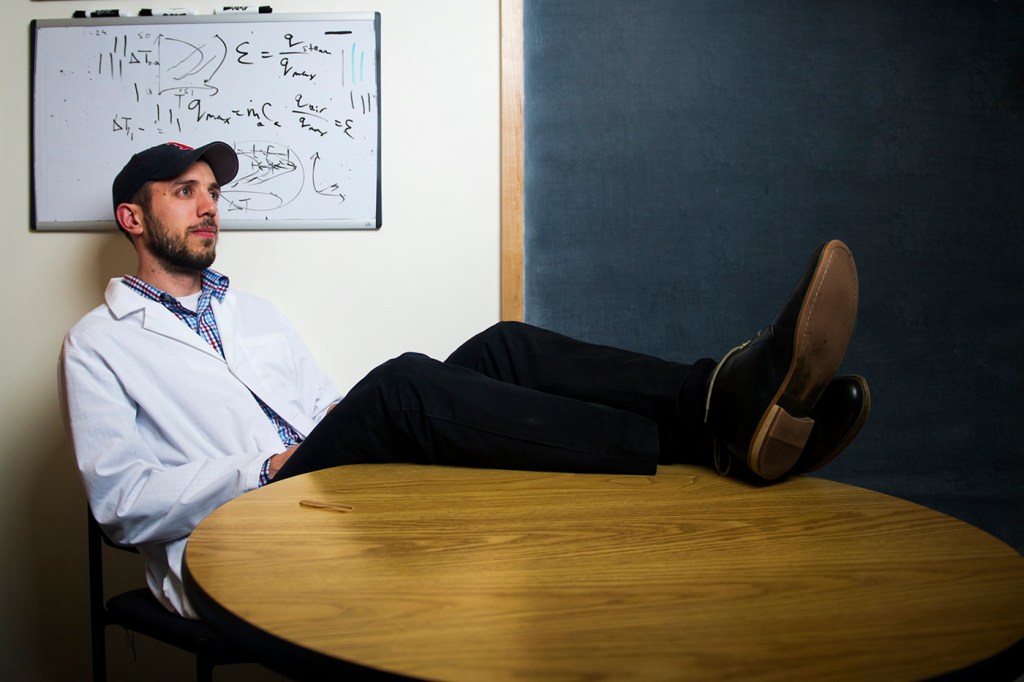PBS wanted to make engineering sound fun. The professor the network chose uses cartoons to teach it.

When PBS wanted to produce a 46-part educational series on engineering, it turned to Northeastern’s Lucas Landherr for guidance.
The network was drawn to the chemical engineering professor for his research into how comics can be used to engage students of all ages in complex subjects. With his wry humor and passion for intriguing anecdotes, Landherr was just what the doctor ordered.
“Opportunities like this don’t come up very often,” he said. “These shows are a fascinating blend of straight lecture, voice over, and animation.”
Engineering is the latest installment of the Crash Course series, which since 2012 has explored biology, chemistry, computer science, ecology, literature, U.S. history, world history, astronomy, physics, and politics.
Opportunities like this don’t come up very often.
Lucas Landherr, Engineering professor
PBS has aired three of the 46 episodes in the engineering series and will continue to roll out a new one on YouTube each Thursday. The first episode has logged 124,000 viewers in two weeks, the second episode has drawn 78,000 viewers in one week, and the most recent episode, released Thursday, pulled in more than 26,000 viewers in one day.
“We focus on the practical application of engineering, not the mathematics,” said Landherr. “Engineering is all about solving problems, and this series focuses on the fundamental concepts engineers have used to change the world.”
Bringing engineering to life
For each of the 10-minute episodes, Landherr spends about five hours conducting research and two hours fact-checking the accuracy of the show’s writers, videographers, and animators.
But his primary task is to mine this vast and highly technical field for the concepts and stories that make engineering fun and important.
In some cases, Landherr brings a complex concept alive with an anecdote about a historic figure. For example, Bernoulli’s Principle, a mathematical principle discovered in the 1700s to explain the conservation of energy, was central to the invention of the carburetor and the airplane wing. But who was Bernoulli? A little bit of digging revealed that Daniel Bernoulli was a child prodigy whose father was so jealous when they tied for first place in a scientific contest, that he threw the boy out of the house. He later plagiarized his son’s work and published it in a book, claiming it to be his own creation.
Daniel Bernoulli was a child prodigy whose father was so jealous when they tied for first place in a scientific contest, that he threw the boy out of the house.
The creator of Carnot’s Cycle, which earned Nicholas Sadi Carnot the title “father of fluid dynamics,” also had daddy troubles, which led to his death at age 36. Carnot’s father was a prominent advisor to Napoleon, and when the feisty emperor was exiled to Elba, the new regime had the younger Carnot declared insane and thrown in an asylum, where he contracted cholera and died. Fearing that Carnot’s tainted manuscripts could spread the disease, they were buried with him.
As a result, we’ll never know what else Carnot discovered during the decade after he published his one and only book at age 27. But thanks to Landherr, students aren’t likely to forget the contributions of these and other groundbreaking engineers.
The early episodes include a host of inventive ways to explore engineering principles. To illustrate the principles of civil engineering, the second episode challenges viewers to imagine the creation of a civilization from scratch on a deserted island. The first episode uses the discovery of a towering blue blob on the sidewalk to explain the difference between the way scientists and engineers approach the unknown.
“Our goal is to excite students with what engineering can do,” said Landherr. “By familiarizing them with the conceptual overview, we create the framework they need for more in-depth learning.”





